A territorial cat is one that regards a particular area, space, or location as her own and will defend it against intruders, including other cats, animals, or even humans. Territorial cats often mark their territory, displaying aggressive behavior and guarding their space. Of course, not all cats are territorial, and the degree of that behavior can vary between individuals.
There are good and bad effects of cats being territorial. First of all, when a cat stakes a claim, that shows she’s feeling comfortable and secure in her environment. That territorial nature can help to minimize conflicts between housemates since when each Kitty knows her boundaries, they are less likely to step on each other’s toes (or tails!)
On the downside, territorial behavior can sometimes escalate into aggressive chasing, swatting with paws, and even a full-scale scrap. That can be a big problem in a multi-cat household and if you live in a neighborhood with lots of outdoor cats. In addition, territorial cats use urine to mark their patch, which is not the kind of home fragrance you’d choose! Scratching a favorite armchair or sofa is another undesirable behavior you sometimes get from a territorial cat who’s marking her territory.
If you have a territorial cat, she will likely mark her patch by spraying urine in particular places and she might scratch in certain spots. If an intruder enters the forbidden zone your cat might chase them away or even launch an attack.
Usually, territorial behavior is caused by a lack of socialization during kittenhood, it could be a result of hormones in non-neutered cats, or might simply be because cats are naturally territorial creatures.
To prevent territorial behavior, you could have your cat desexed, ensure plenty of resources are available for each cat in a multi-cat home, and use hormone diffusers to calm your kitty. If all else fails, it could be worth hiring a cat behaviorist to help you modify your cat’s behavior.
If you have a territorial cat, don’t despair! Keep reading this guide to learn why your pet behaves that way and find out what you can do to modify her behavior.
Are Cats Territorial?
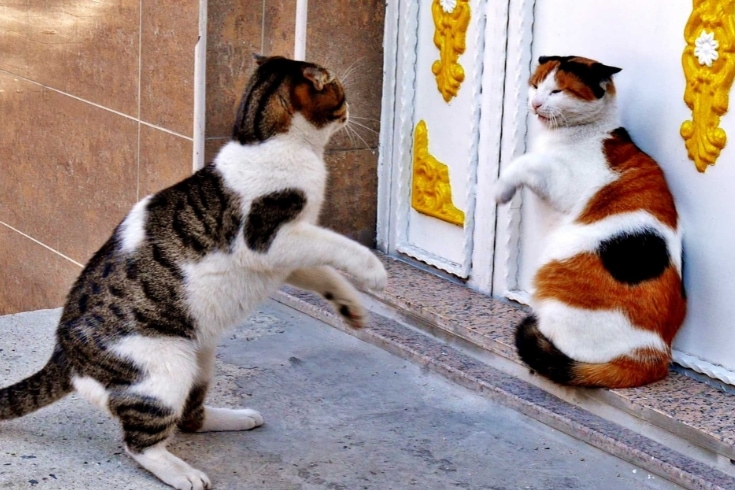
Yes, cats are naturally territorial animals.
According to the territorial definition, some cats consider a specific area, space, or location as their own. They might display aggressive behavior and protect their territory from intruders, including other cats, animals, or humans. However, not all cats are territorial and its intensity varies between individual kitties.
Types Of Cat Territory
Different types of cats’ territory can include core territory, hunting territory, and shared or common territory. Keep reading to learn more about what each type means and work out what kind of territory your cat is defending.
Core Territory
Core territory is the space where your cat feels safe and secure in her environment, usually where she sleeps and around her litter box.
Hunting Territory
Hunting territory is the area your cat claims as hers to hunt. In domestic cats, that could be where she eats and drinks, as well as your backyard or garden where she chases mice and birds.
Shared/Common Territory
Shared territory is the space your cat shares with others in your household, including people, dogs, and or other cats. These areas are generally used for watching, socializing, and generally hanging out.
What Are The Signs Of A Territorial Cat?

The signs of a territorial cat are important to know, especially if you are planning on introducing a new feline to your household.
In this part of our guide, we explain how to spot a territorial feline.
Marking Territory
A cat cannot hang a sign on your front door or in your backyard saying “Property of Tibbles – Keep Out!” Instead, she uses other methods of telling visiting cats, dogs, and wildlife that this is her patch and they should move on.
How Do Cats Mark Their Territory?
Cats marking territory do so in various ways, including using scent. In this part of our guide, we provide an overview of how your feline friend uses her scent to mark her territory.
Scent Marking
Your cat might start scratching items of furniture in your home or particular trees or fences in your garden. That’s because a cat’s paws contain scent glands, and your pet uses them to leave her own particular scent when she scratches.
Urine Marking
Another favorite way of using scent to mark their territory is by spraying small amounts of urine, usually on a vertical surface like a tree or your armchair! In unneutered cats of both sexes, the urine has a particularly pungent smell, as you’ll know if a local Tomcat has sprayed over your garden furniture.
Unfortunately, to be sure the scent doesn’t wash away, the offending cat will return frequently to the same spot to give it a respray!
Aggressive Behavior

Territorial cats often display aggressive behavior toward perceived Intruders on their patch, which can lead to excessive vocalization and fighting in extreme cases.
Guarding Territory
A territorial cat will often guard her territory against all comers, threatening them with her body language, hissing, and yowling.
Vocalizations
A popular method of guarding territory is excessive vocalization, as you will know if you live in a neighborhood with lots of cats outside. I am frequently awoken in the early hours by our local Tomcat shrieking as loudly as he can to frighten the way intruders on his patch.
One of my cats is quite vocal and likes to growl in what she thinks is a frightening way if she spots a strange cat in “her” garden.
Body Language
Cats can use body language to display territoriality, Including stiffening their posture, thrashing their tail from side to side, flattening their ears against their heads, and arching their back.
Chasing Intruders
Many cats, including both of mine, will chase a strange cat or wild animal out of their garden on sight, which is just one of the signs that demonstrate their territorial nature.
Resting In Elevated Positions

As a method of guarding their territory, the cat will often seek an elevated position where she has a commanding view of the surrounding area. For example, one of my cats likes to sit on the garden shed roof from where she can see any strangers approaching from miles away.
Inappropriate Scratching
As already mentioned earlier, cats scratch to leave their scent behind and provide a visible message to anyone crossing through their territory. That’s not such a problem in the garden but it can be a real pain if you have a house cat who decides to leave her mark on your favorite sofa.
Reluctance To Share Space
A territorial cat is often reluctant to share her space with another pet. That reluctance often manifests itself quite subtly. For example, if my little female cat is sitting on the armchair in the conservatory enjoying the sun, her big brother quite often jumps up onto the same chair and literally pushes his sibling off!
What Causes A Cat To Become Territorial?
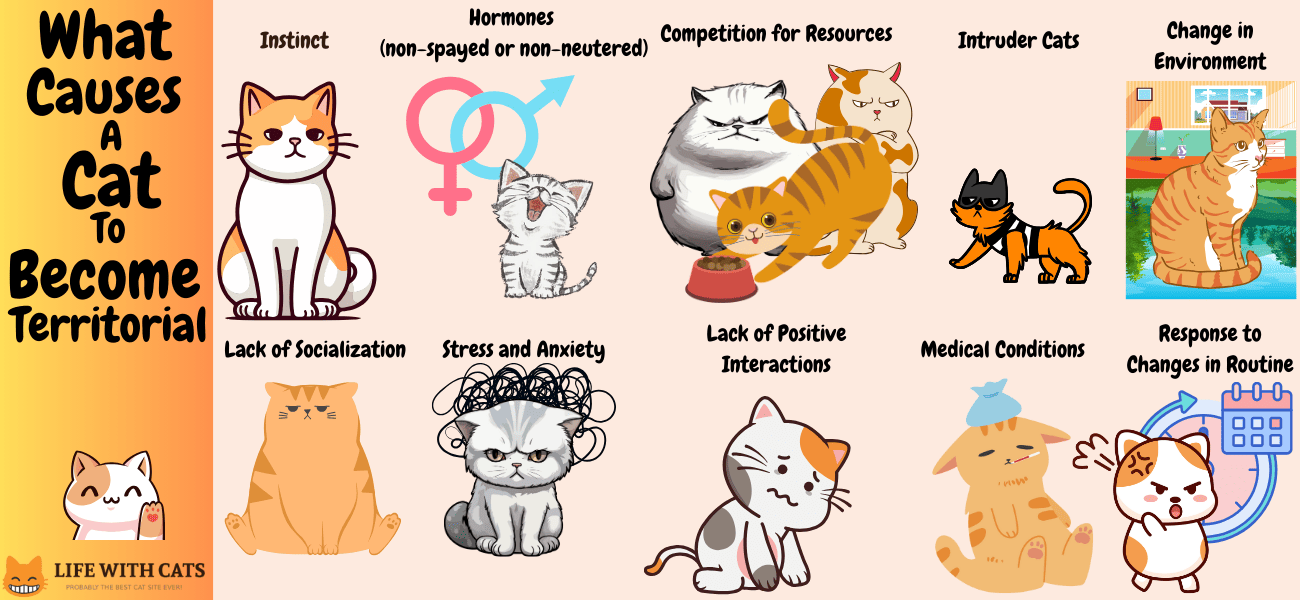
Cats become territorial for quite a few different reasons, which we go over in more detail below. However, the most common reasons behind feline territoriality are natural instinct, lack of socialization in kittenhood, competition in a multi-cat household, and hormones.
Instinct
Wild cats are naturally territorial, generally picking and guarding a patch where there is plenty of prey and moving on to new hunting grounds when that prey becomes scarce. Domestic cats still share that same instinct, even though there’s usually plenty of food for them provided by their doting owners.
Hormones (Non-Spayed Or Non-Neutered)
Although cats of both sexes can be territorial, those who have not been desexed will have more of the hormones that can trigger that kind of behavior than those who have been spayed or neutered.
Competition For Resources
In a multi-cat household, there is often competition for highly valued resources, especially food. Cats can also fight over the best resting spots, toys, and even space on their owner’s lap.
Intruder Cats
A strange cat wandering through your garden or even worse, sneaking into your kitchen can kick off all kinds of territorial behaviors in your resident pets.
Change In Environment

Cats are very sensitive to their environment, and making changes to your pet’s familiar surroundings can trigger territorial behavior. For example, moving home is extremely stressful for a cat and if she feels insecure in her new environment, she might become territorial over one particular area where she feels safe.
Lack Of Socialization
Cats that have not been socialized as kittens can display territorial behavior as they get older, simply because they do not understand how to interact with other cats, pets, and people.
Stress And Anxiety
Stress and anxiety can cause territorial behavior in cats because those emotions trigger feelings of insecurity and even fear. A stressed cat will often choose what she considers to be a safe place, hide there, and guard her sanctuary.
Lack Of Positive Interactions
If your cat has not experienced positive interactions with other cats, family pets, children, and even you, she will feel anxious and insecure, which can trigger territorial behavior.
Medical Conditions
Some medical conditions, including feline cognitive dysfunction, can leave a cat feeling vulnerable and afraid that an intruder will oust her from her home or steal her resources.
Response To Changes In Routine
Cats are very much creatures of routine and like to know when their next meal is going to arrive, when it’s time to go outside, when it’s bedtime, and even when it’s time for a game or training session. A change in routine can leave your cat feeling insecure, worried, and vulnerable, which can trigger territorial behavior.
How Do You Stop Cats From Being Territorial?
To stop cats from being territorial there are quite a few things that you can do, and we provide a full overview for you in this section of our guide.
Spaying Or Neutering
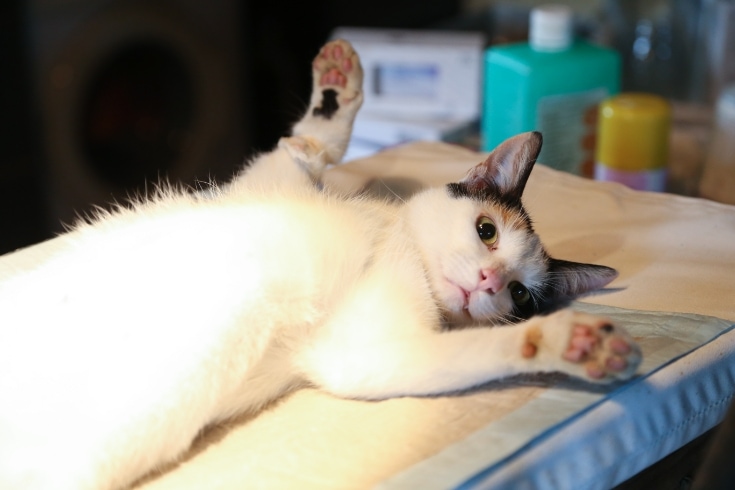
Having your cat spayed or neutered can be a very effective way of preventing or stopping territorial behavior. In addition, cats that have not been desexed are more likely to wander, get into fights, and produce litters of kittens that end up in shelters. So, having your cat spayed or neutered is something every responsible cat owner should do.
Provide Adequate Resources
You can prevent squabbling over litter boxes, water bowls, food, and beds by ensuring you provide adequate resources for every cat and pet in your household. It’s also a good idea to have several scratching posts and cat perches dotted in different locations around your home. That way, all your cats can establish their own little territory, effectively eliminating conflict.
Slow Or Gradual Introductions
When introducing a new pet into a household that already contains one cat, do so slowly and make the introductions gradual. Once the pecking order has been established and the cats settle down, any aggression and territorial behavior should disappear.
Environmental Enrichment
Providing an enriched environment where the cats have plenty to do can go a long way toward preventing territorial behavior. So make sure there are plenty of scratching posts, beds, and puzzle toys to keep the cats entertained and prevent disputes from breaking out over resources.
Scent Mixing
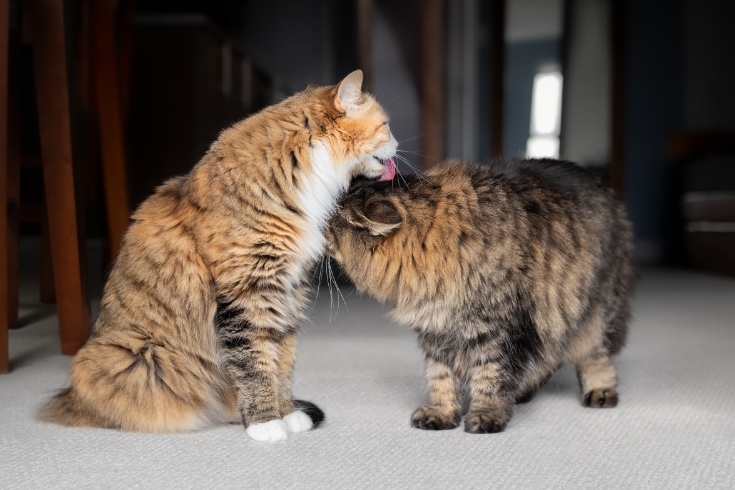
A good way of preventing one cat from becoming a top dog is to mingle the scent of all your cats together. That way, the cats can learn that no one completely rules the roost in your home.
Interestingly, in my house, both my cats share the same scratching post and always mark it when they come in from the garden. My crazy puppy does his best to join in by rubbing his face all over the scratching post! So, all my pets have left their mark in the same place, bonding them together in a weird family group of their own!
Feliway Or Pheromone Diffusers
Pheromone diffusers such as Feliway can be incredibly helpful in calming territorial cats, especially in a multi-cat home where fights break out. You can choose from a plugin, spray, or cat collar containing the pheromone to help create a relaxed, chilled-out vibe that can help reduce territorial behavior.
Positive Reinforcement
Use positive reinforcement to let your cat know when her behavior is pleasing. For example, if a territorial cat stops scent marking on a particular place, be sure to reward her with a treat or a fuss to let her know she’s done right. That way, your cat will be more likely to repeat the desirable behavior in the future.
Consult A Professional
If all else fails, you might need to speak to your vet or hire a professional cat behaviorist to evaluate your cat and offer you some practical solutions to change and modify your pet’s undesirable territorial behavior.
How To Train Cats To Stop Being Territorial?

Cat training can be used to train your cat to stop being territorial. Some of the terms used to train your cat might already be familiar to you since we’ve already mentioned them earlier in this guide. However, all our tips are proven to work pretty well, so why not read on and give our ideas a try?
Positive Reinforcement
Throughout cat training, use positive reinforcement techniques. Positive reinforcement means rewarding your cat with a treat or a game with one of her favorite toys when she exhibits a desired behavior. That way, the cat learns to associate behaving in that way with something positive and is more likely to repeat the behavior in the future.
How to:
- Reward your cat with a treat or a favorite game when she does something you want.
- The cat quickly learns that the behavior she exhibited earns her a reward, so she’s more likely to repeat the behavior in the future.
Pros:
- This form of training helps to build a bond with your cat.
Cons:
- Positive reinforcement training can be less effective if your pet doesn’t respond to treats.
Counter-Conditioning

Counter-conditioning happens when the cat’s reaction or emotional response to something changes from one that is fearful or anxious to one that is enjoyable and positive. For that to happen, you must give your cat a treat every time she is exposed to the trigger of anxiety.
How to:
- If your cat sees a stranger entering her territory, reward her with verbal praise, treats, or a favorite game.
- Your cat will eventually begin to anticipate something pleasant happening when a strange cat crosses her patch, which should help reduce your pet’s territorial behavior.
Pros:
- This training method helps your cat to keep calm in a potentially stressful situation.
Cons:
- This training method might not work for aggressive, highly territorial cats.
Desensitization
Desensitization involves exposing your cat to a trigger that would usually cause her to kick off but at such low levels, she doesn’t respond at all. As your cat becomes less reactive, she is desensitized by exposing her to gradually increased trigger levels.
How to:
- With territorial cats, you could try introducing a strange cat from a distance, gradually increasing the distance until your cat shows no reaction.
- Next, bring the intruder closer to your cat, only stopping when your cat begins to react.
Pros:
- This training technique can teach your cat to remain calm during potentially stressful situations.
Cons:
- This training method might not be effective for cats who are highly territorial or exhibit aggressive behavior.
Redirected Play

Redirected play means giving your cat a hint to reduce a fun game, distracting her from the presence of an intruder.
How to:
- Introduce a strange cat or other pet to the room where your cat is.
- Distract your cat by getting her to play her favorite game with you.
- Your cat should ignore the intruder because her focus is now on the game.
- When your cat doesn’t react to the stranger’s presence, remember to reward and praise her.
Pros:
- This is a great technique to use if your cat loves to play.
Cons
- This technique is sometimes ineffective if your kitty isn’t interested in games.
Behavioral Training
You can train your cat to behave differently by using positive reinforcement as already discussed in depth above.
How to:
- Reward your cat when she doesn’t display territorial behavior when a strange cat enters her patch.
- That way, the cat learns that she will receive a reward when she behaves, making her less likely to react badly in the future.
Pros:
- This method works well if your cat is responsive to reward-based training.
Cons:
- This technique is not effective if your cat is very aggressive and territorial.
Clicker Training
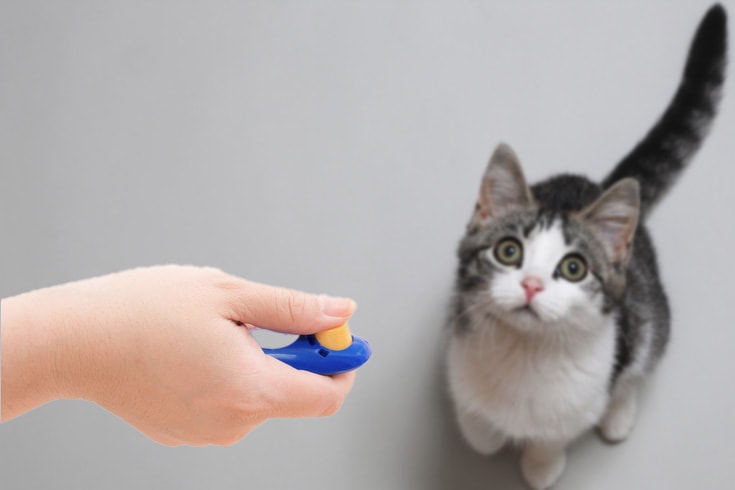
Clicker training involves using a small, handheld device that you squeeze to make a clicking sound. When the cat does what you want her to, click the clicker and give her a reward. That means she learns to expect a reward whenever she hears the clicker, making her more likely to repeat the behavior in the future.
How to:
- When the cat doesn’t react to the presence of an intruder, click the clicker and reward her.
- Repeat the lesson regularly until the cat doesn’t show territorial behavior.
Pros:
- Some cats respond very well to this technique, making it quite effective.
Cons:
- Some cats don’t respond very well to this technique, making it quite ineffective.
Training To Accept Handling
If your cat becomes aggressive toward a strange cat or another animal in her territory, you might need to pick up your pet and remove her before things get violent. Obviously, you don’t want to get scratched or bitten, so you’ll need to use positive reinforcement and rewards to keep your cat calm.
How to:
- Use positive reinforcement techniques as described at length above to teach your cat that being handled is a pleasant experience that will earn her a reward.
Pros:
- This method works fine with cats that enjoy being cuddled and petted.
Cons:
- This method isn’t effective for cats that hate being handled, such as feral or strays.
Teach Relaxation

It’s not easy to teach a cat to relax when she’s in full hunting, territory defense mode, but it can be done.
How to:
- Use positive reinforcement, praise, and rewards to encourage your cat to sit quietly on your lap and be petted when she gets tense to distract her from the intruder in her place.
Pros:
- This method can sometimes work with a cat that enjoys human attention.
Cons:
- This method often doesn’t work with a cat that’s very tense and worked up. Basically, you can’t teach a hyper cat to chill out!
Controlled Socialization
Training your cat to accept having other felines and pets around is extremely important and should really happen from day one.
How to:
- Put the new pet in a crate and allow the resident cat to sniff and say “Hi” without making physical contact.
- If that goes well, you can then allow the newbie out of her crate so that the two cats can make physical contact.
- Be ready to grab either cat if they start to show signs of aggression.
- You might have to go back to the beginning and start over once the cats have settled down.
Pros:
- This method can work well with calmer cats and is a great risk-free way of making introductions, I have used it myself successfully in the past.
Cons:
- If your cat is an out-and-out bully, she might try to attack the stranger in the crate.
Environmental Enrichment
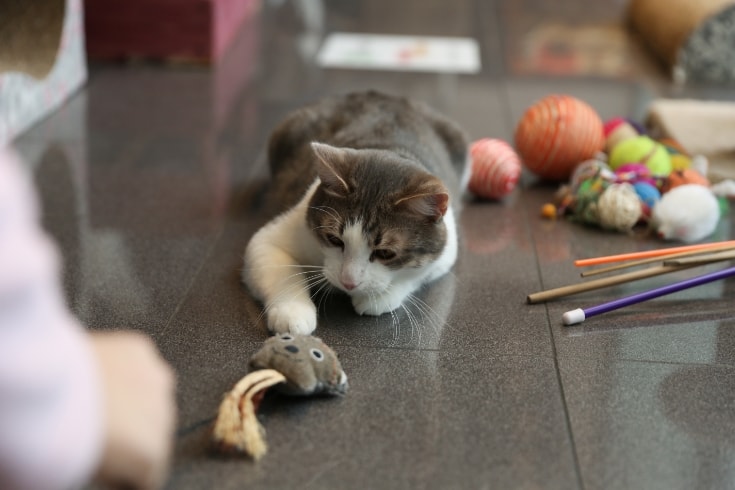
In a multi-cat household where territorial disputes sometimes break out, you can keep the cats distracted and occupied by providing an enriched environment for them.
How to:
- Offer the cats lots of interactive toys to play with, provide a scratching post, and allow the cats access to the outside if appropriate.
- Often, the distraction of having plenty to do helps to relax the cats and keep them occupied physically and mentally so that territorial disputes are less likely.
Pros:
- This is an easy, relatively safe way of introducing a new pet to an existing cat in your home.
Cons:
- If the existing cat is extremely territorial, she will likely chase the other and bully her anyway, so this method won’t work.
Avoid Punishment
Never punish your cat if she becomes territorial. That’s a perfectly natural behavior and doesn’t mean your cat is being naughty.
If you yell at your cat or scold her, you risk damaging the important bond you share and you could even frighten your pet.
FAQs
In this part of our guide, we answer some of the most commonly asked questions about territorial cat behavior.
Is Territorial Behavior More Common In Certain Cat Breeds?
Yes, although all cats have the potential to display territorial behavior, certain breeds such as Siamese and Bengal cats are more commonly associated with it. However, factors like individual temperament, upbringing, socialization, and living environment can significantly influence the intensity of territorial behavior in any cat, regardless of breed.
Are There Specific Situations That Trigger Territorial Behavior In Cats?
Yes, cats are known for being territorial animals, and there are several situations that may trigger that behavior in them. That includes the presence of unfamiliar cats or animals in your cat’s territory, changes in her environment or routine, and feeling threatened or insecure. Additionally, some cats may become territorial over valuable resources such as food, water, napping spots, or toys.
How Can I Prevent Conflicts Between Territorial Cats In A Multi-Cat Household?
Preventing conflicts between territorial cats in a multi-cat household is tricky but it can be done. Start by ensuring each cat has enough space and resources such as food, water, beds, and toys. You can also provide separate litter boxes and scratching posts for each cat and gradually introduce them to each other over time, ideally under supervision.
Is It Possible To Train A Cat To Accept New Additions To The Household Without Territorial Issues?
Yes, it is possible to train your cat to accept new additions to the household without territorial issues. The key is to introduce the new pet or person gradually and in a controlled way by using positive reinforcement techniques, such as giving treats and praise. However, if your cat continues to be territorial despite your efforts, you might need to get professional help from a vet or expert cat behaviorist.
When Should I Consider Seeking Professional Help For My Cat’s Territorial Behavior?
If your cat’s territorial behavior is causing problems such as aggression towards people or other pets, destructive behavior, or excessive scent marking, it might be time to seek professional help. A vet or cat behaviorist can provide expert advice and guidance on how to manage and modify your cat’s behavior. Remember, it’s important to deal with territorial issues early to prevent them from escalating into more serious problems.
Conclusion
A territorial cat can be a real pain, especially if she’s aggressive and excessively vocal when a strange cat or other animal invades her patch.
You can use various training methods to stop your cat from being overly territorial, such as counter-conditioning, desensitization, controlled introductions, and redirected play. Throughout your training sessions, always use positive reinforcement and never punish your cat if modifying her territorial behavior proves to be challenging.
If your cat is extremely territorial, she could become aggressive toward you and other pets, as well as spraying around your home and becoming destructive. Use our top tips to train your beloved feline friend to be less antisocial and more willing to share!